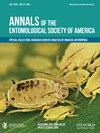Mating Communication of the Variegated Leafhopper, Erasmoneura variabilis, With Notes on Vibrational Signaling of Other Grapevine Cicadellids in California
IF 1.8
3区 农林科学
Q1 ENTOMOLOGY
引用次数: 1
Abstract
Abstract Leafhoppers in the tribe Erythroneurini are a concern for grape growers in California due to direct feeding damage by piercing the leaves. Management of leafhopper populations in vineyards may be accomplished by insecticide applications, the release of natural enemies, conservation biological control, exploitation of controlled deficit irrigation, or a combination of the above. Based on research on other leafhopper species, a behavioral mating disruption is a viable option, but nothing is known about the mating communication and circadian signaling of these species in vineyards. The objectives of this study were to identify and describe vibrational signals associated with mate selection behavior of Erasmoneura variabilis and Erythroneura ziczac, and evaluate the occurrence of vibrational signals within sympatric populations of E. variabilis, E. ziczac, and Homalodisca vitripennis on grapevines. Analysis of vibrational communication signals revealed that 1) one female signal and two distinct male signals are used in E. variabilis pair formation, 2) the pair formation process in E. variabilis is divided into three communication phases, 3) E. variabilis pre-copulatory communication is longer in the presence than in the absence of male-male rivalry, 4) two distinct signals are used in E. ziczac pair formation, and 5) E. variabilis, E. ziczac, and H. vitripennis sing at night and during the day. Results include detailed descriptions of leafhopper communication signals that are relevant for future development of vibrational disruption as a novel method to suppress populations under field conditions.斑纹叶蝉(Erasmoneura variabilis)的交配交流及其对其他葡萄蝉类振动信号的记录
摘要:红脊灰蝶是加利福尼亚州葡萄种植者关注的一个问题,因为刺入叶片会直接造成食源性损伤。葡萄园中叶蝉种群的管理可以通过施用杀虫剂、释放天敌、保护生物控制、利用受控亏缺灌溉或上述方法的组合来实现。根据对其他叶蝉物种的研究,行为交配中断是一个可行的选择,但对葡萄园中这些物种的交配交流和昼夜节律信号一无所知。本研究的目的是识别和描述与可变Erasmoneura variabilis和紫锥红蛛择偶行为相关的振动信号,并评估振动信号在葡萄藤上可变E.ziczac和Homalodisca glascpennis共病群体中的发生情况。对振动通信信号的分析表明,1)一个雌性信号和两个不同的雄性信号用于变异E.variabilis的配对,2)变异E.variailis的配对过程分为三个通信阶段,3)变异E.variabilis在有雄性竞争的情况下交配前的通信比没有雄性竞争的条件下更长,4)在E.ziczac对的形成中使用了两个不同的信号,并且5)E.variabilis、E.ziczak和H.vanicpennis在夜间和白天唱歌。结果包括对叶蝉通信信号的详细描述,这些信号与振动破坏作为一种在田间条件下抑制种群的新方法的未来发展有关。
本文章由计算机程序翻译,如有差异,请以英文原文为准。
求助全文
约1分钟内获得全文
求助全文
来源期刊
CiteScore
4.90
自引率
0.00%
发文量
25
审稿时长
6-12 weeks
期刊介绍:
The Annals of the Entomological Society of America exists to stimulate interdisciplinary dialogue across the entomological disciplines and to advance cooperative interaction among diverse groups of entomologists. It seeks to attract and publish cutting-edge research, reviews, collections of articles on a common topic of broad interest, and discussion of topics with national or international importance. We especially welcome articles covering developing areas of research, controversial issues or debate, and topics of importance to society. Manuscripts that are primarily reports of new species, methodology, pest management, or the biology of single species generally will be referred to other journals of the ESA. The most important criteria for acceptance are quality of work and breadth of interest to the readership.

 求助内容:
求助内容: 应助结果提醒方式:
应助结果提醒方式:


